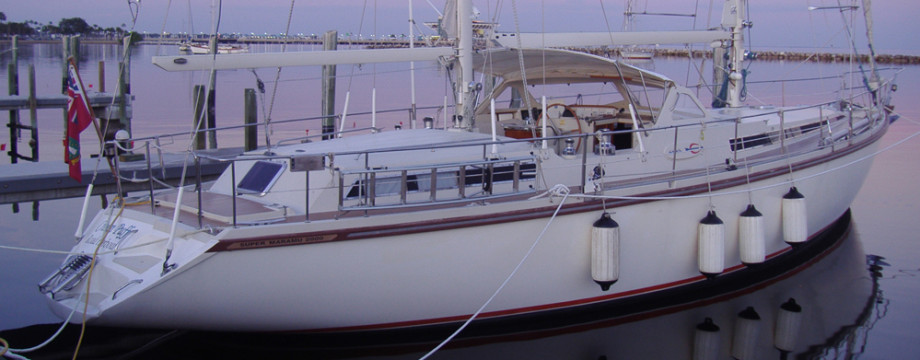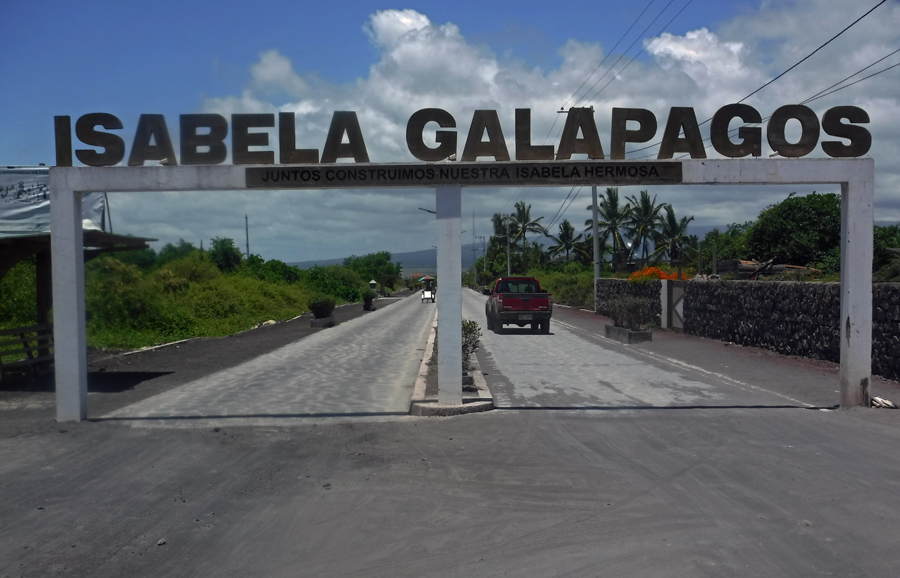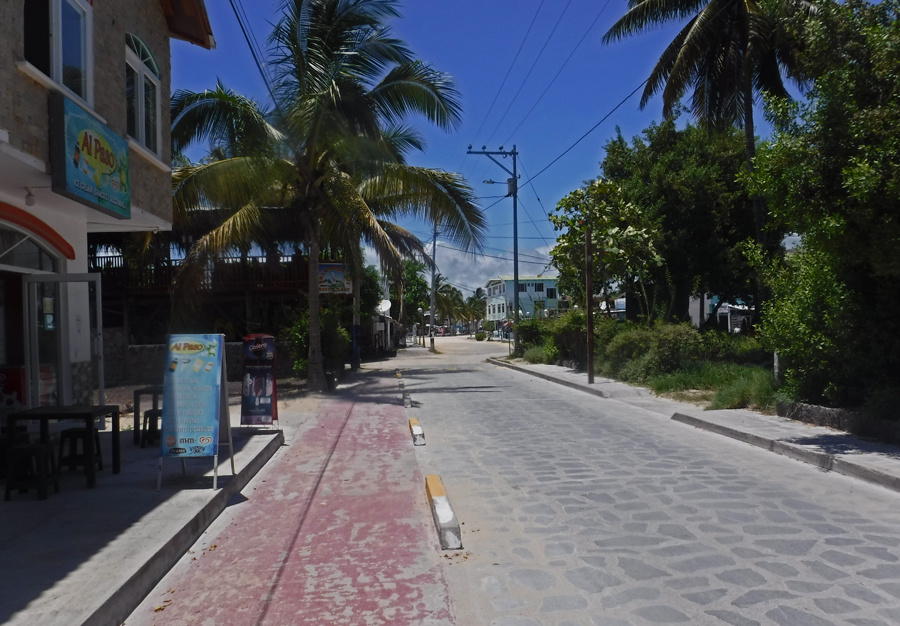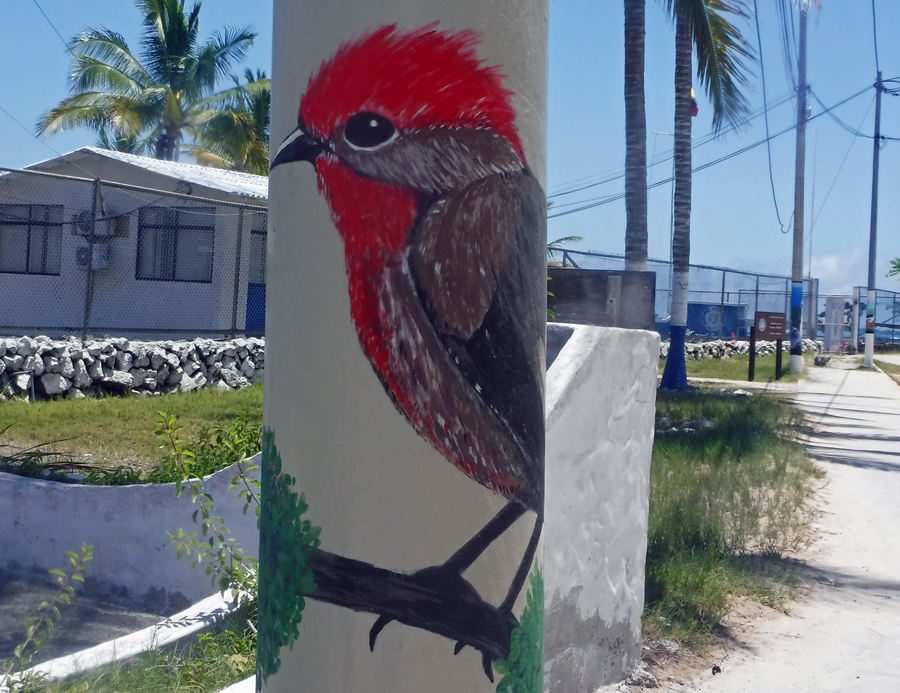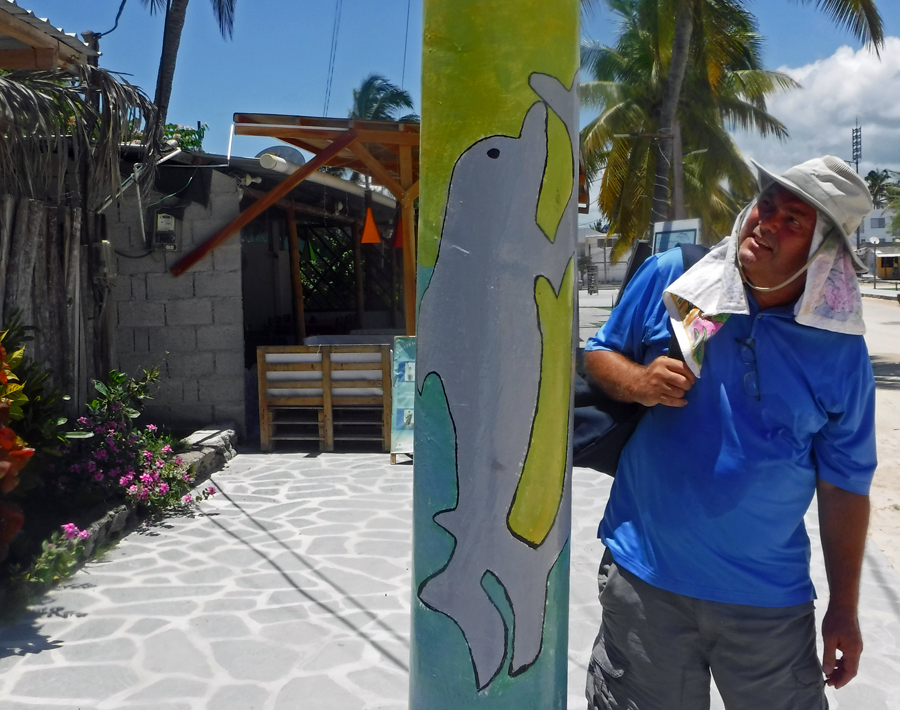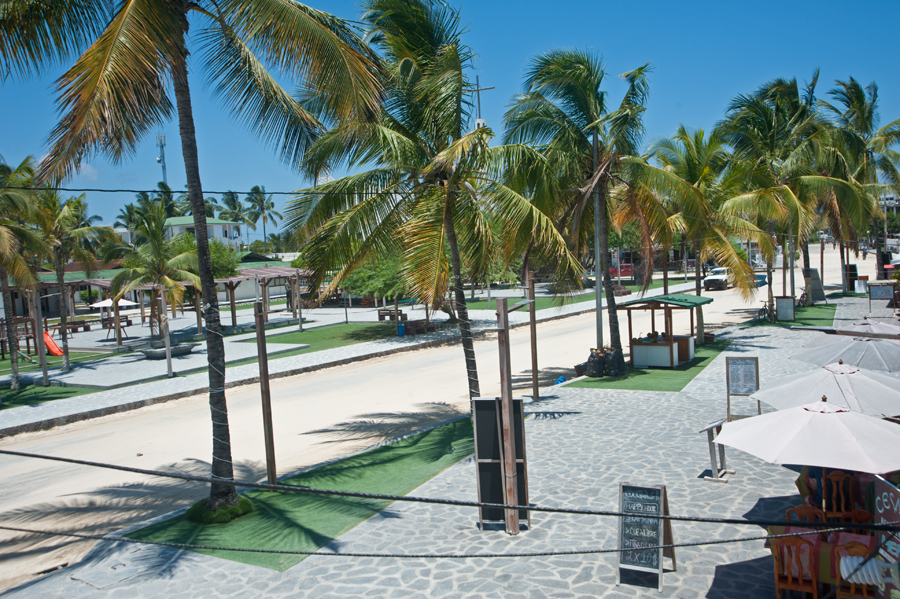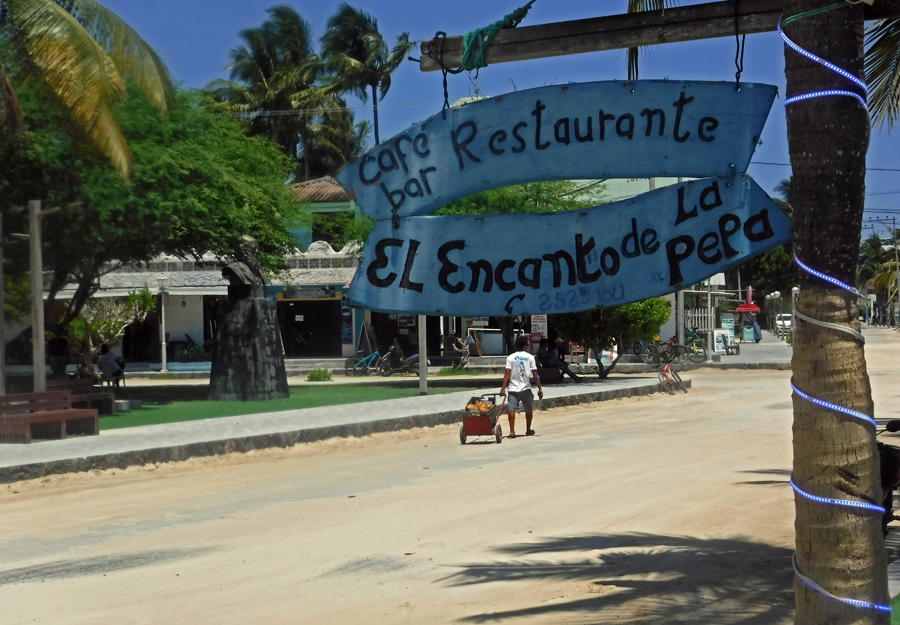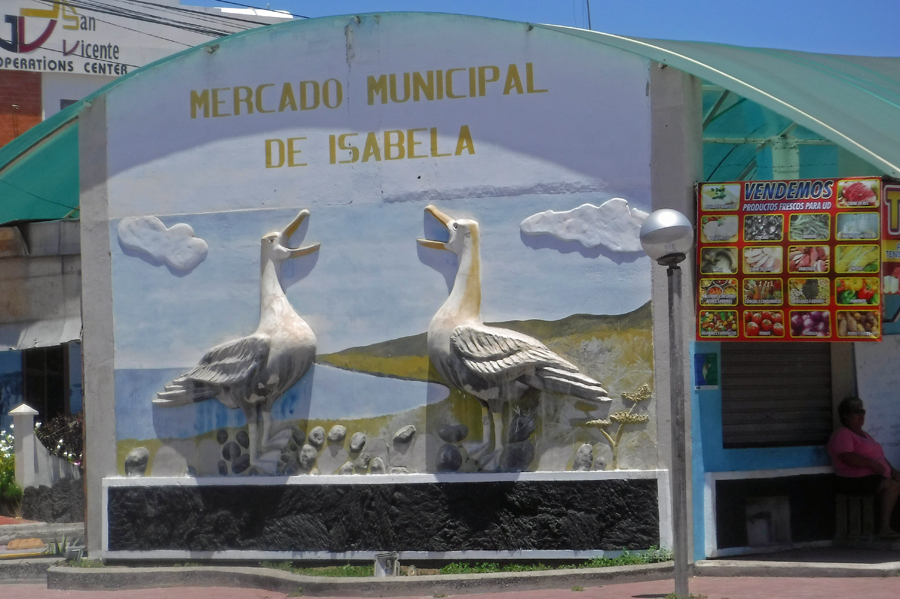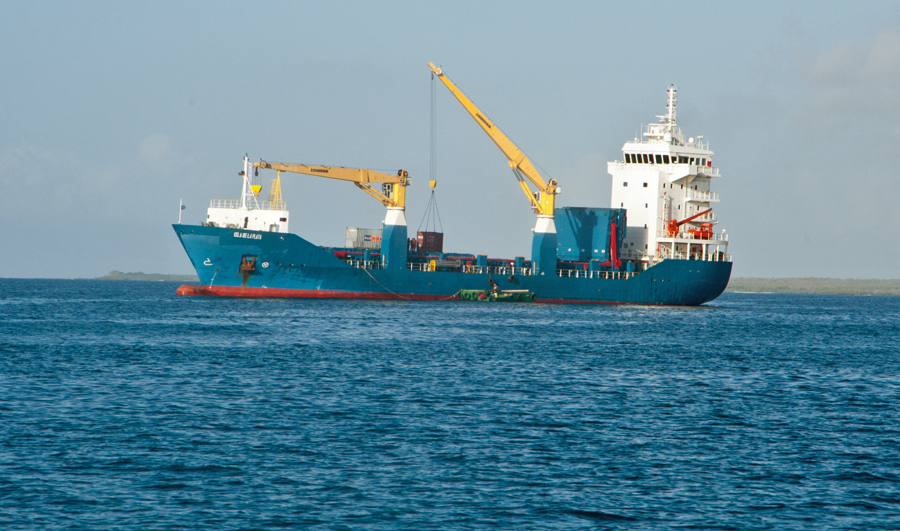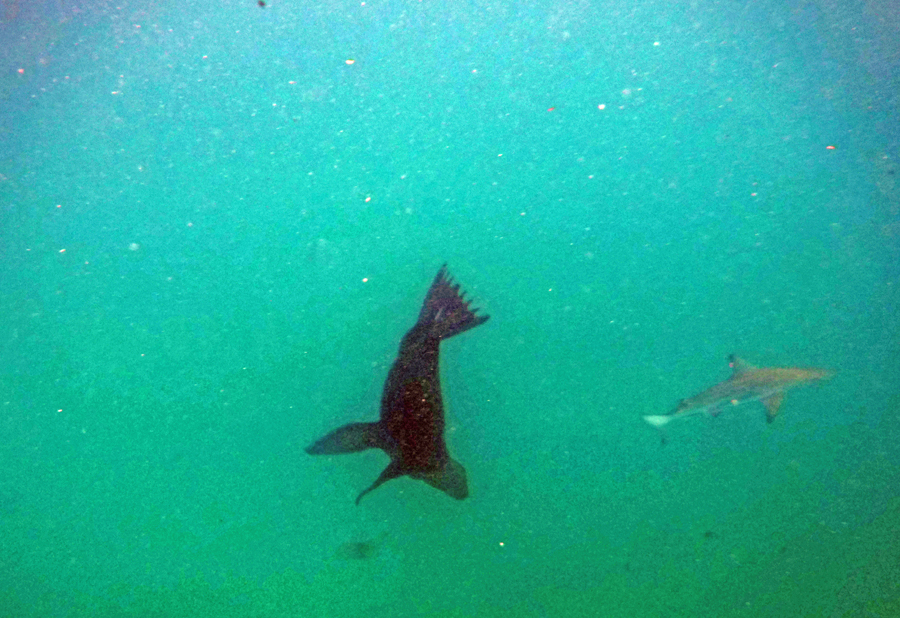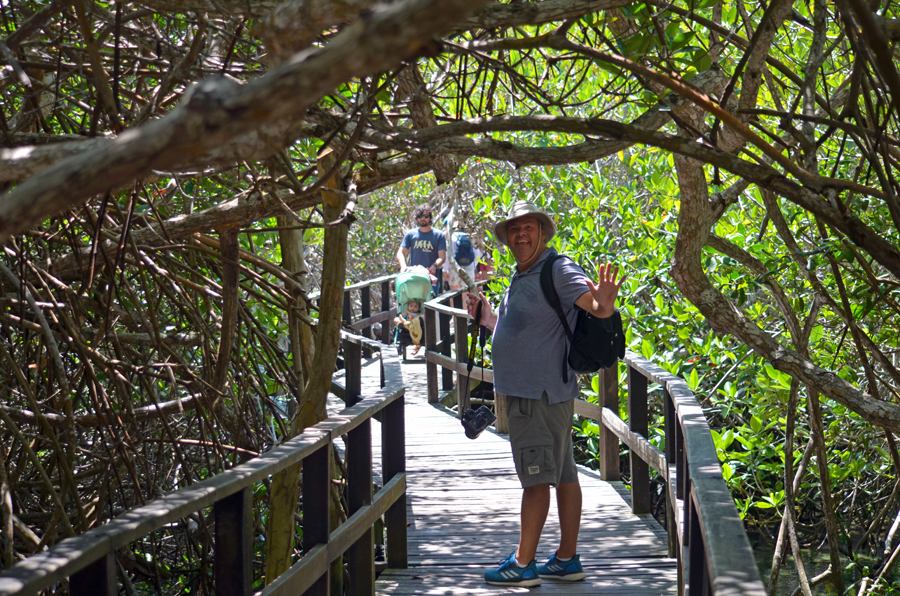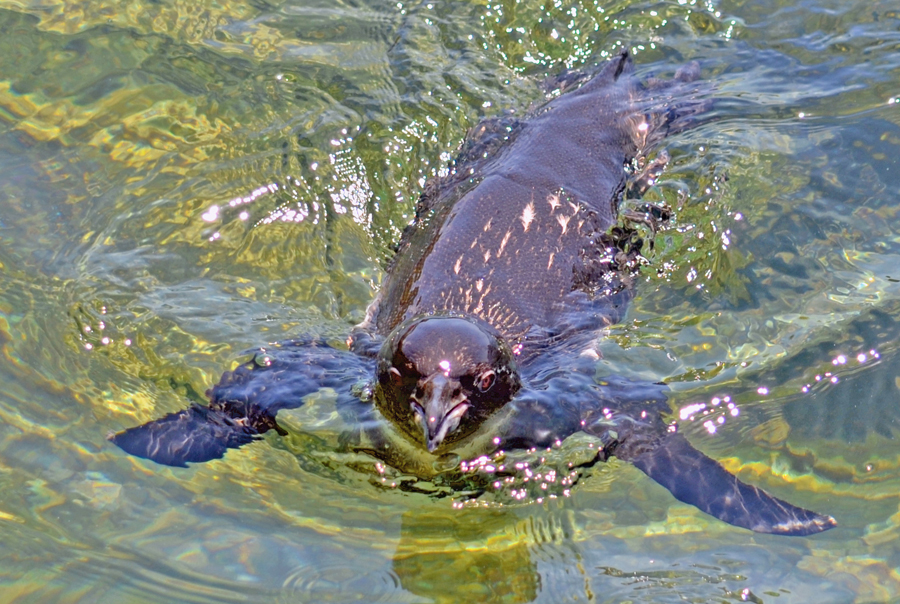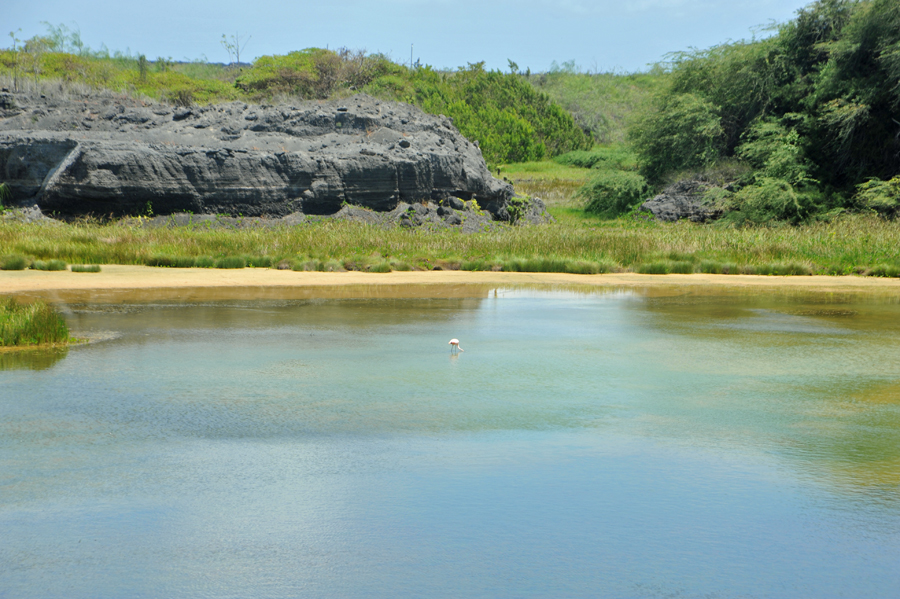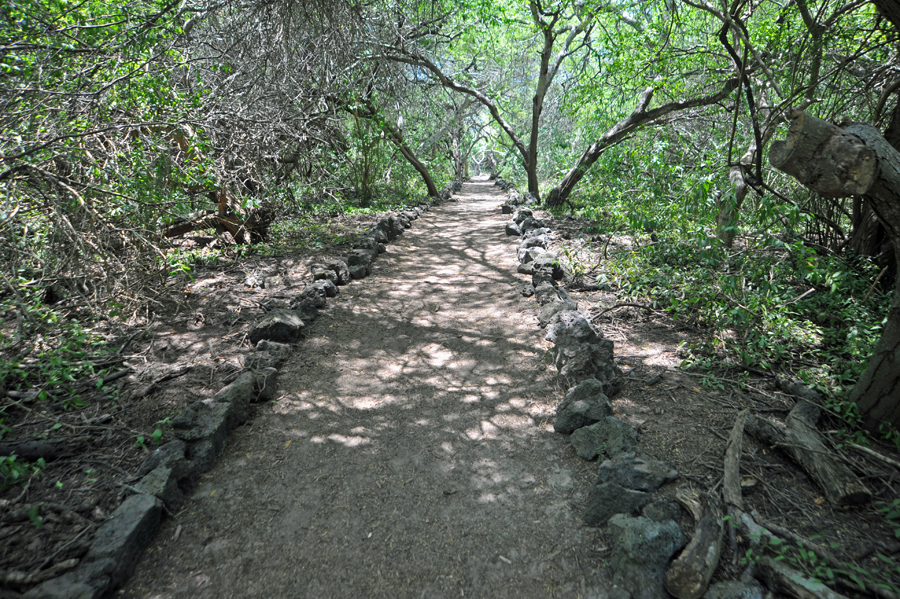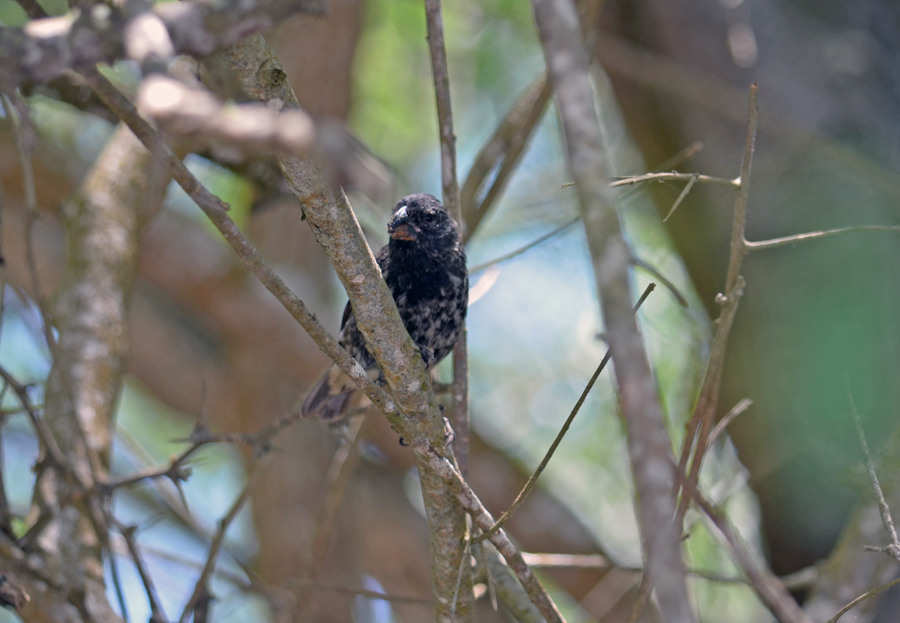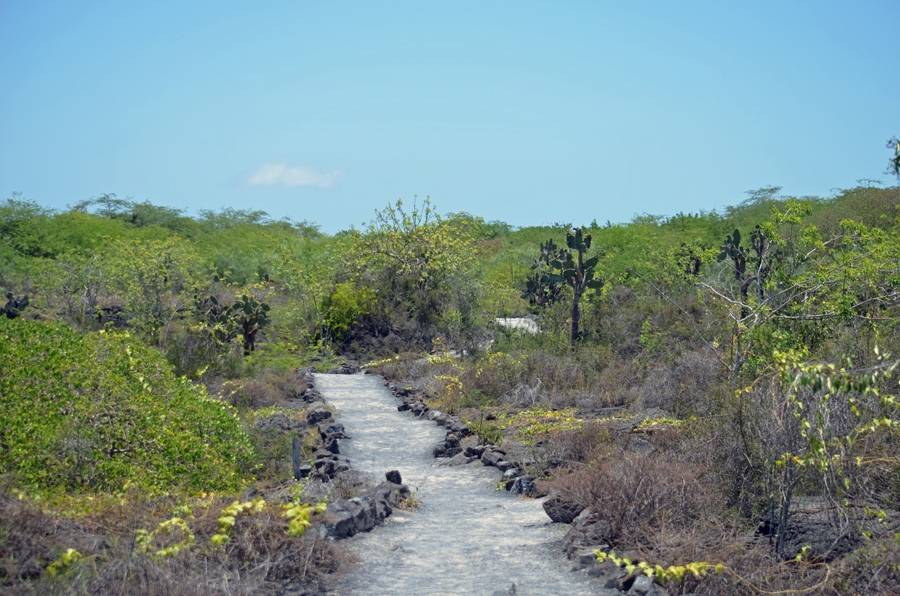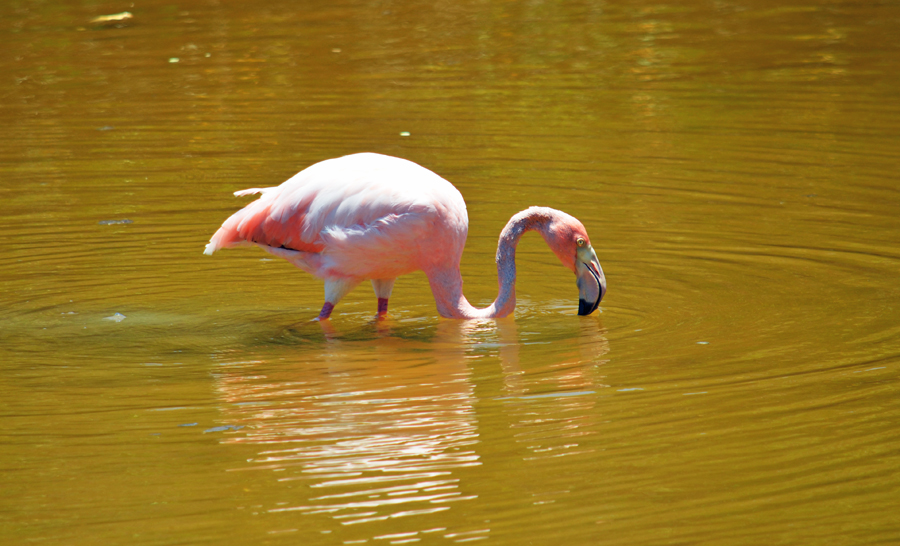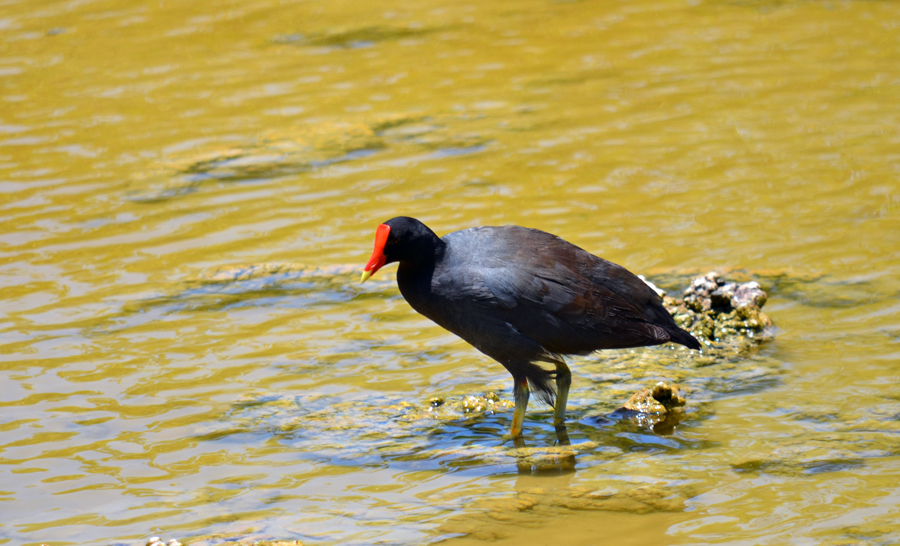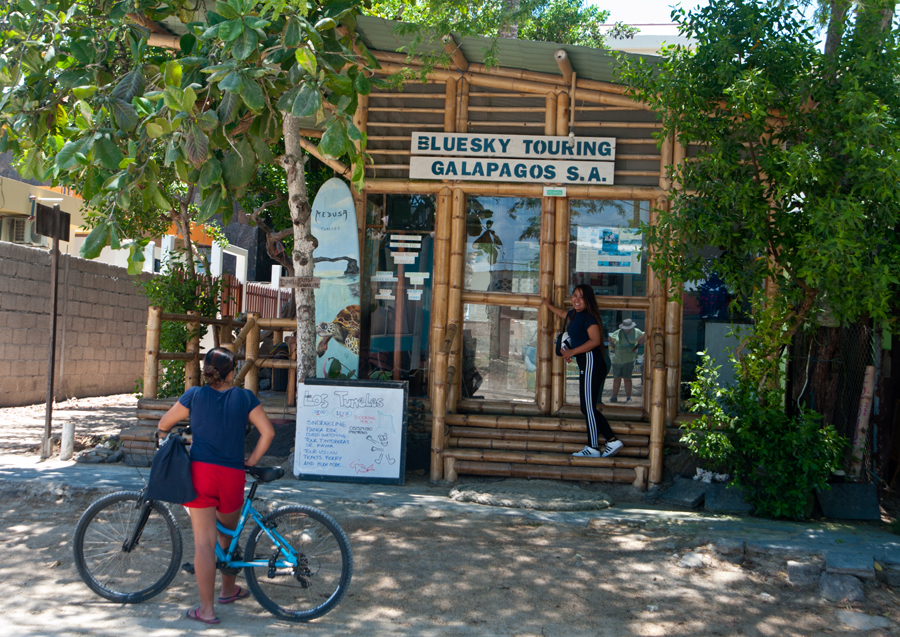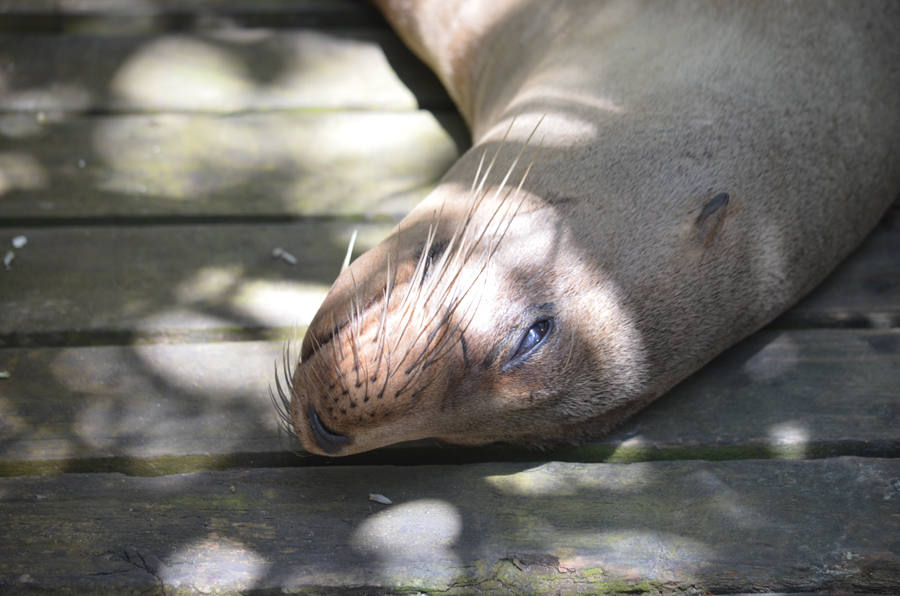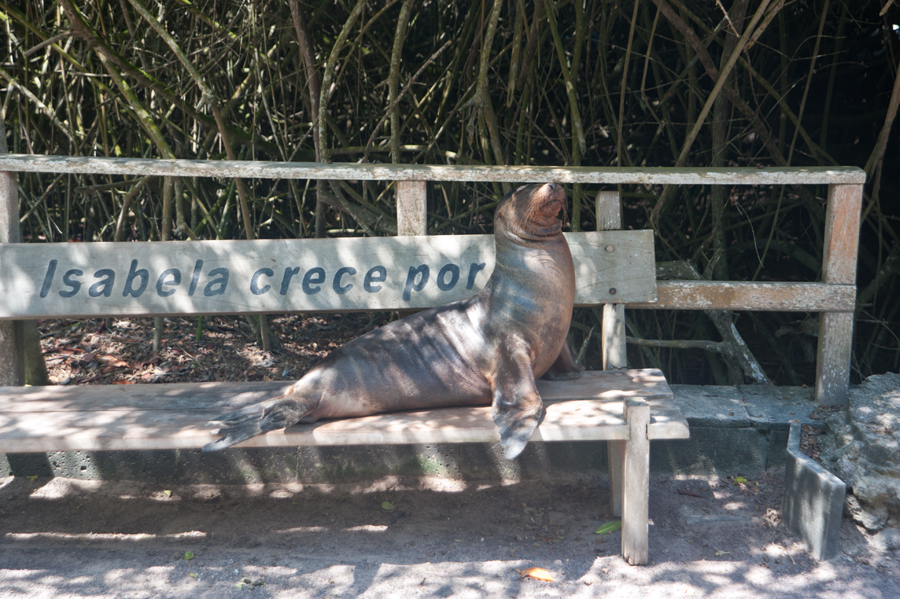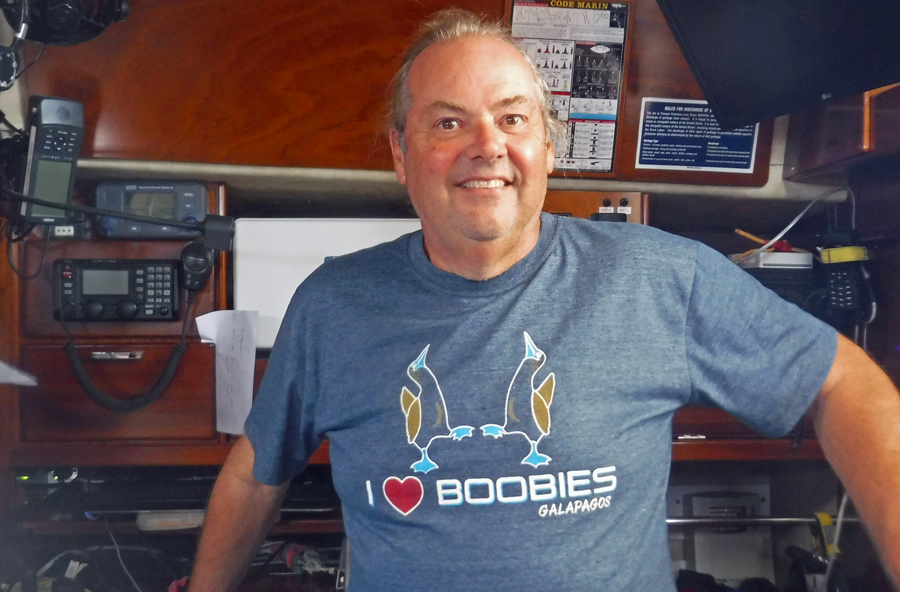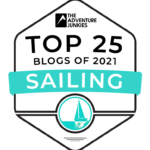Karma caught up with us. In our previous post, I gave the ARC boats a hard time for not using stern anchors and basically not looking at surrounding boat’s ground tackle before they picked their anchor location. Well, when it came to for us to leave, we had an issue retrieving our stern anchor. It may have been caught on a rock but I’m not really certain what snagged it. We eventually took the anchor line from the stern to the bow so we could use our powerful windless to pull in the rope. Even the windless struggled a little bit. Cream Puff was moving about as we tried for about half an hour to retrieve our anchor making the neighboring boats a little nervous. The other captains sat in their cockpits eyeing the shenanigans nearby. The anchor eventually gave and after about an hour delay we set sail for our last stop in the Galápagos, Puerto Villamil on Isabela Island.
I use the phase set sail very loosely. Wind has been lacking here for a few days and we wound up motoring the approximately 50 miles. This was a disappointment because we are trying to conserve diesel. When we leave here, our next journey is about 3,400 miles and needless to say we’d like to have as much fuel as possible. According to the rules, we are allowed only one fill-up in Galápagos. The fill-up takes place on San Cristóbal Island and we did this during our stop there. The weather forecast had promised 15 knot winds but we never saw any wind in double digits. Cream Puff just doesn’t move in less than 10 knots. Well, she does but it would take us so long to arrive our required check-in at the next Island would then become problematic.
Now we have arrived in Puerto Villamil on Isabela Island, we are starting to look at weather windows to leave here. We need a decent wind to get us to the trade winds, about 200-300 miles southwest of here. For us, this about a day and a half sail. The rules of Galápagos allow us to check-out from Isabela but to do so we must pay $100 for customs and immigration agents to come to this island by ferry. The alternative is to go back to Santa Cruz and check out from there thus using more diesel. Galápagos does not have agents on this island. And because they have to come by ferry, they require 3 days notice to check-out. Most countries will give 48-72 hours to leave after checking-out but Galápagos requires us to leave immediately. This doesn’t give us much room for error in picking a forecast. A forecast is usually accurate for about 3 days; anything beyond this is an educated guess. If we leave here and have to motor the first 200 miles, this is going to eat into our diesel reserves.
The bottom line is we are going to sit here until we are absolutely certain we’ll have wind to get to the trades. And as it turns out, this is not a bad place to be. This is the largest island in the Galápagos chain and also the most sparsely populated. Fewer than 2,000 people live here fulltime. Isabela is more like I envisioned Galápagos. The town of Puerto Villamil is a sleepy town built around a square. The other townships on previous islands were much more touristy, but not in a bad way. This island is more rustic. “Restaurant row”, as the locals refer to the street has about a dozen dining choices all very reasonably priced. None of the restaurants were busy for lunch. I have to assume there are times when the island gets busy but we have yet to see it.

Inca Kola
There are a few hostels scatted about town. Don’t let the word hostels fool you. Some are very elegant. For the most part, this island is a little bit off the tourist path. Each day we see a couple of large tour boats unload their passengers into dinghies and head for shore. They don’t stop for more than the day. Besides the cruisers and the tour boats, all other visitors to the island arrive by ferry from Santa Cruz. We can buy the basics here from a small supermarket but fruits and vegetables are lacking. Lucky us, we even managed to top off our phone data at a local shop. At the same store, we also grabbed a cold drink. I tried Inca Kola. It tastes like bubblegum soda. It was better than I am making it sound. Nobody seems to be in a hurry to go anywhere. It took us about two hours to walk about most of the town. And we are walking very slowly. It is darn hot here.
During our first day on the island walking the town, we ate lunch at El Velero. The $10 lunch special included soup, salad, entree (choice of ten), sides, dessert and juice. It was pretty good. Our server was Venezuelan and spoke perfect English. It makes ordering food so much easier when the waiter can understand us. We asked him if the taxis on the island are white pickup trucks like the other islands. He said most are but some are not. I inquired as to how we are supposed to tell if a taxi is a taxi. He laughed and said after living on the island for a while; he just knew which taxis were and which aren’t. Then, he helped us get a taxi back to the water-taxi dock. He did this after I tried to hail a truck that turned out to be his boss coming to the restaurant.
The water taxi zig-zags its way to Cream Puff. The bay in which we are anchored is riddled with reefs. Upon arrival, we pushed in as far as we dared and made sure we stay among the other boats at anchor. Our nautical charts do not have much detail regarding depths and reefs in this bay. I’m glad we did tuck in a little bit because a large freighter was anchored and the process of unloading it has gone on for four days now. The unloading of the ship is amazing to watch. The ship, anchored in the deeper waters about a mile from the dock, unloads a single container onto a barge. The barge looks barely seaworthy. The barge is then moved to shore by a guy using a small boat and an outboard motor. They somehow manage to weave their way through the few private boats here toward the town dock. At the dock is a crane. It doesn’t remove the full container. They open the top and lift out the contents onto waiting trucks. Then they return the empty container to the ship. This process starts at sunrise and ends at sunset. You are probably thinking like I am, there has to be a better way. I have to assume because of the low population of the island, the expense of building a dock for a container ship is just not justifiable.

Amazingly, this guy pushes the barge between anchored boats and over the reefs. Note the sleeping seals on the buoy.
A couple of cruising boats here are brave enough to take their dinghy to the reefs and snorkel. This is very risky. The island is volcanic. The shore’s sharp lava rocks will easily puncture an inflatable dinghy. I can’t imagine the headache of having to deal with a dinghy repair out here in the middle of nowhere or arriving in French Polynesia needing to buy a new dinghy. Our agent strongly advised us to not use the dinghy in this bay. After a trip on the water-taxi and seeing the reef lurking just below the surface, I thought the advice was well warranted. We read on a couple of cruising forums how some sailors totally lost their dinghies in this bay. The best way to explore the reefs surrounding the bay is in a kayak. You can wave at penguins perching on the lava as you paddle.
The thing I love about this island is we do not need guides to see the land stuff. Just about everything except the volcano tour is within walking distance. There is even a lagoon where we can snorkel a short walk away from the water-taxi drop-off. We timed our visit to this lagoon when we noticed no large tour boats here in the anchorage. At first, we were a little disappointed. But then, things really changed. We hovered over a really large school of fish. It was the large number of fish themselves that caught our interest. Then we notice sharks swimming under the fish. Not big ones, they were about 2 feet long and paid no attention to us. All of a sudden, the fish got really excited. A couple of seals were looking for lunch and this was their dining room.
Seals are incredibly fast underwater. Often times the fish are within a foot of the seal’s snout but somehow manage to live another day. Even with speed and agility, the seals have a tough time getting lunch. The water was a little murky and getting a good picture was just about impossible. We found ourselves with prime seats in an episode of The Crocodile Hunter.
Where else in the world can you see penguins and flamingos within a half-hour walk of one another? Where else in the world can you watch a person exit the ocean and walk up a beach only to be followed by a seal doing the same? Where else in the world can you see a turtle, sharks, feeding seals, swimming marine iguanas, penguins, and tropical fish all in the same lagoon without having to swim more than 100 yards? This was how I had always envisioned Galápagos and it hasn’t disappointed.
Grabbing a land-taxi at the water-taxi dock, we asked the driver to take us to the lagoon where the flamingos hang out. He did us one better. In English, he told us about a trail. He explained he’d drop us at the far end of the trail and told us how to walk back to town on the trail. This was awesome. Had we found the trail ourselves in town we’d have had to walk twice as far. It ends in the boonies and we’d have to walk back the way we came. Sometimes we get lucky with a good cab driver. It’s nice to have Karma back on our side.
He dropped us just past the end of the trail where the road had a view of a salt flat. Flamingoes love salt flats. We all had a good laugh when we peeked over the ledge only to spot a single lone flamingo. The driver said not to worry; we’d see more on our walk back. He was right.
As we started off down the trail, Cindy and I joked about the one loan flamingo. Cindy dubbed him Lonesome Fred, a play on the stuffed tortoise in the Darwin Research Center called Lonesome George. The trail neared the Isabela Tortoise Park. Believe it or not, we are a little bit giant tortoised out. We decided to hunt for flamingoes instead and continued down the trail. At first, we had the luxury of shade. We took our time stopping to look at birds and lizards.
The trees disappeared and we questioned our sanity walking at almost the hottest part of the day in the hot equatorial sun. I can feel the hot gravel burning my feet through my shoes. Some tourists passed us going the other way. They look as hot as I feel. One of the young ladies was lobster red. I am thinking how that is going to hurt tomorrow. It isn’t long before we find more flamingoes and our heat fatigue gives way to excitement.
At the end of the trail we are hot and hungry. We mosey down the middle of the sandy streets. There is so little traffic here. Perhaps we are passed by a vehicle every 10 minutes, or so. I honestly didn’t think we could do much better than the $10 lunch special we enjoyed on our first day here. Surprise! We find a place with a $7 lunch special. A lot of locals were there eating; a good sign. Lunch consisted of fresh chicken soup for the starter and fried chicken, rice and beans for the main course. It also included a large glass of guava juice. Yum! Like most restaurants here, the dining is outside (shaded but not air-conditioned). One of the reasons we chose this restaurant was its upstairs location allowing it to be open on three sides, meaning the light breeze would help cool us off. For some reason, nobody uses fans here. Our plan worked, after a couple of bottles of cold water we relaxed and settled in to enjoy the fine food.
Galápagos is proof human and animals can exist side by side. We have stepped over sleeping seals, almost stepped on iguanas and lizards, looked giant tortoises in the eye, and watched various birds from a couple of feet away. Even the fish seem at ease. The animals here are completely unafraid of humans. It is an amazing place.
We had a list of animals we wanted to see while here in Galápagos. During the passage here we made the list and read about the animals. We are fifteen for fifteen: Red footed booby, blue footed booby, brown booby, Darwin finch, giant tortoise, seal, penguin, sea lion, albatrosses, marine iguana, sally light-foot crab, flamingo, sea turtle, lava lizard, frigate birds. In addition, we saw tons and tons of other animals. Something as simple as taking a walk along a trail can turn into a National Geographic moment. Seeing these animals in their natural environments is really something. I will always treasure this experience.
The question we are asked over and over from cruisers east of here is, is it worth it. This has been our most expensive stop to date. Our total with all the fees is about $2,200. The answer is overwhelmly a big yes from both of us. It is definitely worth it. I say this not just because we like to see animals in their natural environment but because the towns on the islands are fantastic gems. On the days when we were not looking for strange critters unique to these parts, we enjoyed a walk and meal in town. We will never regret stopping here.
As you read this, we have departed Galápagos and are en-route to French Polynesia. We estimate this sail will take us between 20-25 days. So, the blog is going to be quiet for a little while. We hope you enjoyed the posts about Galápagos.
